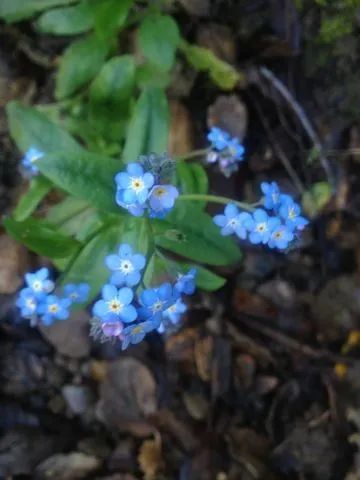
Author: Poir.
Bibliography: J.B.A.M.de Lamarck, Encycl., Suppl. 4: 45 (1816)
Year: 1816
Status: accepted
Rank: species
Genus: Myosotis
Vegetable: False
Observations: Macaronesia
The Broadleaf forget-me-not, scientifically named Myosotis latifolia, is a captivating and distinguished member of the Boraginaceae family. This perennial plant draws the curiosity and admiration of botanists and gardeners alike due to its delicate structure and striking floral displays.
Originally documented by Poir., Myosotis latifolia was first described in detail by J.B.A.M. de Lamarck in the supplement to his Encyclopedie in 1816. This scholarly work has provided a solid foundation for the botanical understanding and classification of the plant.
Native to the Macaronesia region, which includes groups of islands like the Azores, Madeira, and the Canary Islands, the Broadleaf forget-me-not thrives in their unique climatic conditions. These varying environments, from lush, moist conditions to rocky terrains, contribute to the plant’s adaptability and robustness.
The Broadleaf forget-me-not is renowned for its broad, velvety leaves which set it apart from other members of the Myosotis genus. The foliage is often a rich green, providing a striking background for the dainty, five-petaled flowers that typically bloom in shades of blue, although variations can sometimes exhibit pink or white hues. Each flower, despite its small size, holds a striking beauty with a central, eye-catching yellow or white eye.
This species is not just a visual delight but also carries significant cultural and symbolic meanings. Often associated with remembrance and true love, the Broadleaf forget-me-not serves as a reminder of enduring connections and fond memories.
In the wild, Myosotis latifolia contributes to the biodiversity and ecological health of its native habitats. It can often be found flourishing in shaded woodlands, grassy meadows, and along the edges of streams, where it benefits from the moist soil and ample shade.
Gardeners who cultivate Broadleaf forget-me-not may find it relatively easy to grow, provided the plant is given the right conditions that mimic its natural habitat. It prefers cooler climates with partial shade and consistently moist, but well-draining soil. When planted en masse, Myosotis latifolia creates a beautiful, carpeted effect, making it a popular choice for borders, woodland gardens, and shaded areas.
In summary, the Broadleaf forget-me-not or Myosotis latifolia is a botanically and aesthetically significant plant that continues to fascinate and enchant those who grow it or encounter it in its natural settings. Its origins in the verdant and diverse landscapes of Macaronesia, coupled with its charming appearance and easy cultivation, ensure that it holds a beloved place in both wild environments and cultivated gardens.
Deu: breitblättriges vergissmeinnicht
Eng: broadleaf forget-me-not
Spa: nomeolvides de monte
En: Broadleaf forget-me-not, Remember-me, Wood Forget-me-not, Woodland Forget-me-not
Ca: Miosotis de bosc
Zh: 阔叶勿忘草
Nl: Bosvergeet-Mij-Nietje
Fi: Kanarianlemmikki
Fr: Myosotis des bois, Myosotis des forêts
De: Breitblättriges Vergissmeinnicht, Wald Vergißmeinnicht, Wald-Vergißmeinnicht
It: Nontiscordardimé dei boschi
Es: Nomeolvides de monte, No me olvides de jardín
Taken Jun 20, 2020 by carabomm (cc-by-sa)
Taken Aug 27, 2019 by Victor Rios (cc-by-sa)
Taken Nov 3, 2020 by casielles mario (cc-by-sa)
Taken Apr 16, 2016 by EOL − Damon Tighe (cc-by-nc)
Taken Mar 21, 2020 by Ritchie Latham (cc-by-sa)
Taken Jun 15, 2021 by Micifor L (cc-by-sa)
Taken Oct 6, 2022 by Michaelangela Janssen (cc-by-sa)
Taken Aug 26, 2021 by sharon bell (cc-by-sa)
Taken Sep 30, 2021 by courtney Marm (cc-by-sa)
Taken Mar 4, 2022 by Betty Groove (cc-by-sa)
Taken Feb 22, 2013 by EOL − Thomas Valdriz (cc-by-nc)
Taken Feb 27, 2012 by EOL − Ken-ichi Ueda (cc-by-nc)
Taken Mar 7, 2015 by EOL − Ken-ichi Ueda (cc-by-nc)
Taken Mar 9, 2014 by EOL − George Chrisman (cc-by-nc)
Taken Aug 24, 2018 by Tela Botanica − Sylvain Piry (cc-by-sa)
© copyright of the Board of Trustees of the Royal Botanic Gardens, Kew.
© copyright of the Board of Trustees of the Royal Botanic Gardens, Kew.
Growth habit>: Forb/herb
Family: Myrtaceae Author: (F.Muell.) K.D.Hill & L.A.S.Johnson Bibliography: Telopea 6: 402 (1995) Year: 1995 Status:…
Family: Rubiaceae Author: Pierre ex A.Froehner Bibliography: Notizbl. Bot. Gart. Berlin-Dahlem 1: 237 (1897) Year:…
Family: Sapindaceae Author: Koidz. Bibliography: J. Coll. Sci. Imp. Univ. Tokyo 32(1): 38 (1911) Year:…
Family: Asteraceae Author: A.Gray Bibliography: Pacif. Railr. Rep.: 107 (1857) Year: 1857 Status: accepted Rank:…
Family: Fabaceae Author: Medik. Bibliography: Vorles. Churpfälz. Phys.-Ökon. Ges. 2: 398 (1787) Year: 1787 Status:…
Family: Aspleniaceae Author: (Cav.) Alston Bibliography: Bull. Misc. Inform. Kew 1932: 309 (1932) Year: 1932…